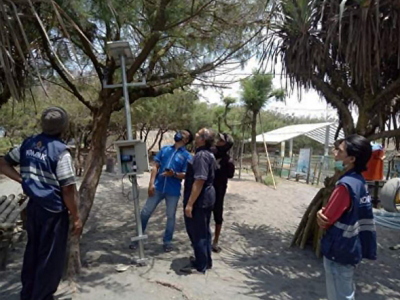
Turtles are sea-dwelling reptiles. Turtles can cross the Indian Ocean, the Pacific Ocean, and Southeast Asia on long migrations. The combination of natural factors and human activities that directly or indirectly put the population of turtles in danger puts them in a difficult situation. These creatures are sensitive to light, noise, cleanliness of the environment, and crowds, which frequently disturb turtles that are laying eggs. The decline in turtle populations as a result of human activities—threats from nature in the form of climate change, disease, or the threat of predatory animals—is caused by damage to coastal habitats, deaths as a result of interactions with fishing activities, inadequate management of conservation techniques, and uncontrolled hunting of turtles and their eggs.
Changes in weather and climate are crucial to turtle breeding. Consequently, a few instructors from the Staff of Designing planned a turtle reproducing observing device model. The environment's temperature and humidity (air and sand) can be detected by this tool's sensor system. Purno Tri Aji, M.Eng., and a web browser based on the Internet of Things make up the monitoring tool's development team. Remote monitoring is possible using an Android application and the browser. M.Pd. Muhammad Irfan Luthfi, Muhammad Izzuddin Mahali, M.Cs, Dr. Eko Marpanaji, and two understudies, in particular Danang Wijaya and Muhammad Dzulfiqar Amien.
Purno Tri Aji says that changes in cold weather can make it harder for turtle eggs to hatch. At the point when the temperature is chilly, the turtle egg incubating disappointment rate can reach half. " Due to a lack of heat in the nests under the sea sand, many turtle eggs cannot hatch during the cold weather. Also, cold weather will make it take longer for turtle eggs to hatch, he said on Saturday (20/8). Turtle eggs will hatch after 40 days of incubation in normal weather at 30 degrees Celsius, while they will hatch after 55 days in cold weather at 20 degrees Celsius. The hatching of turtle eggs in semi-natural nests on the southern coast of Java was also significantly impacted by the wet-dry season. The state of this season makes the sand in the semi-normal home be damp with the goal that the turtle egg undeveloped organisms don't form suitably into hatchlings and even neglect to bring forth. Additionally, the conditions of damp sand can allow organisms to enter the eggshell through the pores, resulting in the embryo's decay and the failure of the turtle eggs to hatch.
According to Muhammad Irfan Luthfi, conservation efforts for turtles include the following:
1. Keeping an eye on how turtles naturally lay and hatch eggs.
2. Captive breeding, which includes activities such as egg transfer, semi-natural hatching, hatchling maintenance, and hatchling release
3. Keeping an eye on or keeping an eye on turtles (including keeping an eye on nests and eggs, hatchlings, and turtles laying eggs).
4. Tagging, preserving turtles in migration corridors, and promoting natural and semi-natural habitats.
Irfan likewise made sense of that the administration of turtle-based the travel industry was additionally a worry of the UNY group. As part of the UNY lecturer team's community service-based research and development, ten members of the konservasi penyu pantai pelangi participate in this activity.
Members of the konservasi penyu pantai pelangi receive practical training in tool troubleshooting in addition to the tool installation. The lecturer team evaluated and monitored the progress of the already installed monitoring tools at the location at the conclusion of the activity. Both the difficulties associated with using the tool and the results of the tool received feedback from participants. The lecturer team responds to participant feedback by providing direction, suggestions, and solutions. This training activity proved to be very helpful to the participants. Tj. Dedy Lak)
